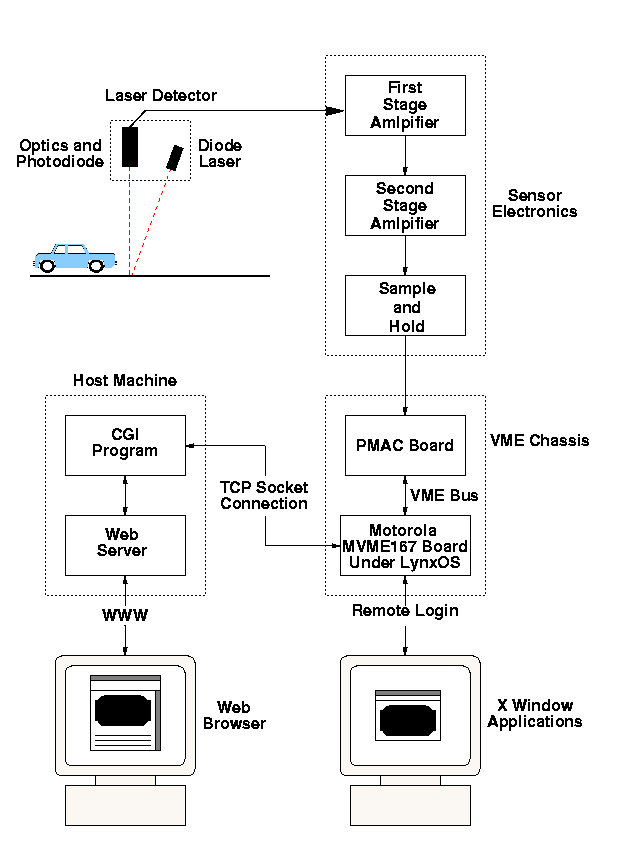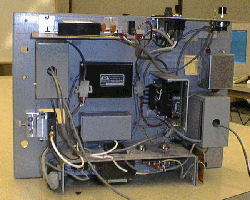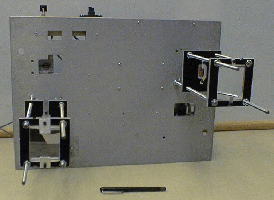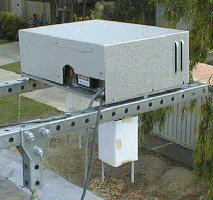
Figure 1: System Overview
| Current Prototype | Fourth Prototype | Third Prototype | Second Prototype | First Prototype |
The first prototype for indoors had been built and tested, yielding some good results and some problems. The overview of the first prototype is shown in Figure 1. A toy truck, shown in Figure 2, was used to simulate a vehicle passing under the laser system which proved that the theory is sound. The laser system was able to find the amount of time a vehicle was under the sensor consistanly. A sample of the output is shown in Figure 3. It however, did not function as well as planned in all areas. Durring testing, a few problems were found. Some of these were fixed in the first prototype to help with testing. The others are going to be addressed in the next generation of the prototype.

Figure 1: System Overview
|
|
|
Laser and Sensor Optics
A field prototype has been built for field tests. Two off-the-shelf integrated diode laser systems, ML20A15-L2 diode laser systems from Power Technology Inc. are used as the laser sources. This laser system can be pulsed at a maximum rate up to 10 kHz. Its high performance and small size make it a good candidate for use in the field deployable prototype system. A wavelength of 905nm for the laser was chosen for a number of reasons. Infrared light has good transmittance through fog, giving the system better performance under a larger range of weather conditions. Furthermore, the intensity of sunlight around the wavelength of the laser is a local minimum, giving the system better rejection of noise due to sunlight. An infrared laser was also thought to be more appropriate for outdoor use because it is invisible to the human eye, and would therefore cause no distraction to passing motorists. In the field-deployable prototype it is also necessary that the laser be eye-safe. Calculations indicate that the laser power intensity of our detection system is below the minimum national laser safety standard by a large margin.
The sensor optics consist of an imaging lens system and a telescopic lens system. The imaging lens system focuses the reflected laser light onto the active area of the sensor array. A bandpass filter that is matched with the wavelength of the laser is used to reduce the level of ambient light received by the sensor. The telescopic lens system is mounted in front of the imaging lens system. It is designed to restrict the field-of-view of the imaging lens along the width of the laser line, but not alter the field-of-view along the length of the line. Because the laser line is much longer than it is wide, use of the imaging lens alone would result in a much wider strip of pavement being visible to the sensor than is desired. The telescopic lens system is used to match the dimensions of the laser line image with those of the sensor array. Figure 4 shows configuration of the laser detection system. The size of the system is measured as 25*18*5 inches.



Figure 4: (Left) Top View of the System, (Middle) Bottowm View of the System, (Right) Whole System View.
System Electronics
A 25-element avalanche photodiode (APD) array is used as the sensor in our detection system. The sensor converts the reflected laser light into a current signal. The sensor circuit is the main part of the electronics hardware in the detection system. Low-cost high-speed amplifier chips with suitable bandwidth were chosen meet the high demand of our detection system for signal amplification. Only 4 of the 25-elements of the APD array will be used. Future generations of this prototype will try to utilize more elements.
Data Acquisiton System
Since the signal output from the sensor is a pulse signal, a component is need to transfer the pulse singal into a useable signal. A PMAC-PC board is used to take in the pulse signals and convert them into a digital signal. The digital signals can then be used to determine when the laser is blocked and calculate a passing vehicle's speed.
The data acquisition software is used to collect, process and display data from the hardware of the detection system. The data are read from the output of sensor electronic circuit periodically. All tasks have to be done at the same time. However the data are to be acquired in the same interval from the hardware. In other words the data acquisition task should be deterministic, otherwise information will be lost. The concurrence of the deterministic tasks requires real-time performance of the operating system. A PMAC (Programmable Multi-axis Controller) DSP board and A/D converter are used as the data input device. The data acquisition software is a multi-thread program running in a real-time Lynx operating system. The data from the laser detection system are acquired by the PMAC board in a certain interval and written into a buffer in a dual-ported memory by the device driver. The user level application software reads data from the buffer in the device driver, processes it in different threads to obtain vehicle data, and displays the results in a GUI. The most critical real-time tasks are done primarily by the PMAC board, which is a complete computer system.